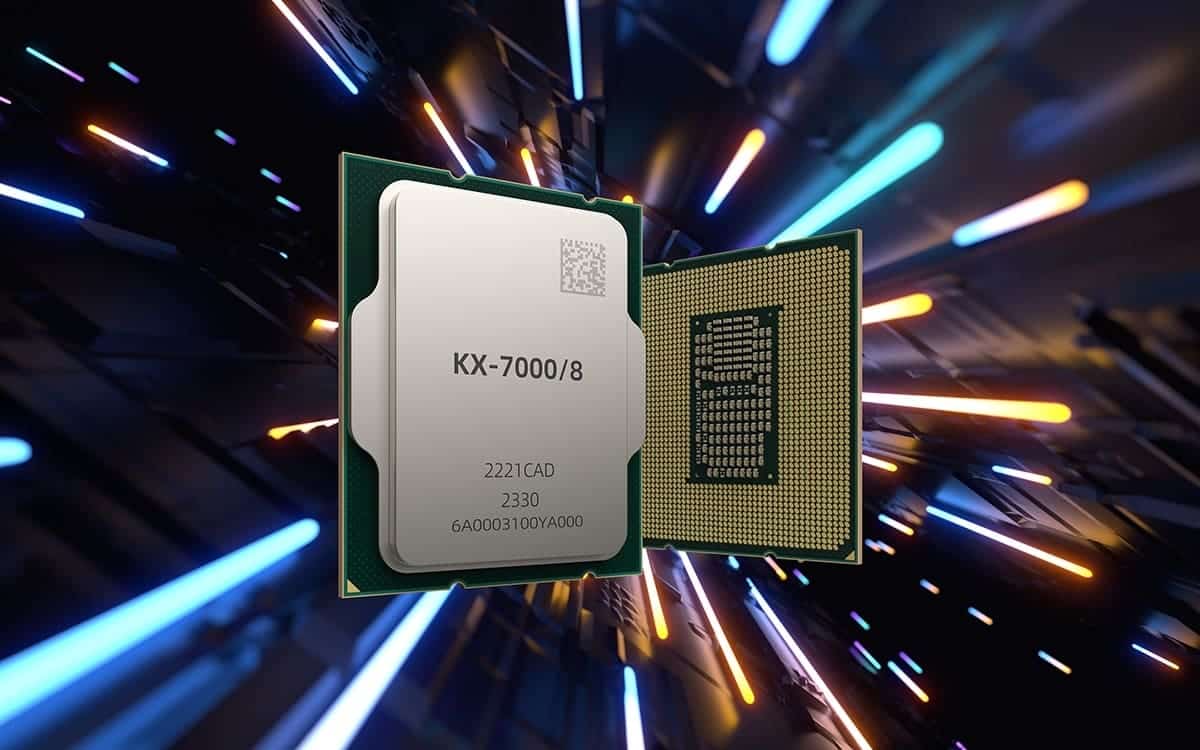China has taken a significant step forward in its technology strategy by launching a desktop computer equipped with its own x86 processor, designed by Zhaoxin and integrated by MAXHUB. The new device, called AI+ PC, aims to establish itself as a genuine alternative to systems based on Intel and AMD processors—the two giants that have dominated the global x86 chip market for decades.
This announcement comes at a crucial time. For years, the Beijing government has been promoting domestic manufacturers like Loongson and Zhaoxin to reduce Western technological dependence. While Loongson has pursued its own architectures such as LoongArch, now Zhaoxin is championing the cause of domestic x86, a licensed architecture that allows running the broader global software ecosystem.
Zhaoxin KX-7000: a Chinese-made x86
The Zhaoxin KX-7000 is the flagship processor of this initiative. It’s a chip built with a 7 nm chiplet design, featuring 8 cores and 8 threads, with full compatibility with 32-bit and 64-bit x86 instruction sets, including extensions like AVX.
On the technical side, the chip incorporates:
- 4 MB L2 cache and 32 MB L3 cache
- A maximum frequency of 3.6 GHz
- An integrated GPU, the C-1190, supporting DirectX 12, OpenCL 1.2, and OpenGL 4.6, alongside H.265/H.264 decoding and dual 4K output
- A proprietary interconnection architecture, ZPI 4.0, uniting the CPU and I/O die within a single package
The design mirror’s Intel’s LGA 1700 socket, clearly aiming to create a product comparable in form and function. Initial tests show the KX-7000 doubles the performance of the previous KX-6000, marking a significant upgrade for China’s local ecosystem.
MAXHUB AI+ PC: a compact computer with integrated AI
The first system to feature this processor is the MAXHUB AI+ PC, a 10-liter desktop computer that emphasizes hardware-integrated AI functions.
Notable features include:
- A compact, minimalist design that can be placed vertically or horizontally
- Simplified wiring architecture with direct connections, reducing faults from oxidation or disconnection
- Passive, silent power supply up to 180 W
- Video outputs including VGA, HDMI, and DisplayPort, along with multiple USB-A ports at 5 Gbps and gigabit Ethernet
But what truly sets it apart is the AI-assisted software. MAXHUB has developed a system where features like smart image cropping, document conversion, automatic text extraction, and direct streaming to large-format screens are integrated into the workflow. This means the system anticipates user needs rather than just executing commands—it’s about proactive assistance.
Performance and testing
During initial demonstrations, the system showed solid performance in multimedia and productivity tasks:
- Playing 1080p and 4K videos at 30 fps without frame loss, with CPU usage between 29% and 36%
- Smooth operation of office applications like WPS Office, even with large documents
- Cloud transfers (Baidu Netdisk) reaching normal speeds of around 25 MB/s
- Stress testing with AIDA64 for nearly four hours, maintaining temperatures around 84°C with no stability issues
Graphically, while the integrated GPU doesn’t match dedicated solutions like Intel Arc or AMD Radeon, it provides enough power for video, basic editing, and AI-enabled office work.
A market in full technological transition
What sets the KX-7000 apart from other Chinese processors is its emphasis on compatibility. Unlike alternative architectures such as ARM, MIPS, or LoongArch, this chip effortlessly runs the global x86 software ecosystem, enabling Windows and Linux applications with minimal barriers.
In China’s CPU ecosystem, the landscape looks like this:
- Kunpeng and Feiteng: ARM-based chips focusing on servers and embedded systems
- Shenwei (Sunway): an SW64 architecture used in supercomputers
- Hygon: AMD Zen1-based processors oriented toward servers
- Loongson: transitioning from MIPS to LoongArch, an indigenous architecture
- Zhaoxin: the sole general-purpose x86 provider for both PCs and servers
MAXHUB’s move isn’t isolated. It aligns with China’s goal to build a self-sufficient hardware and software ecosystem, in line with the “technological sovereignty” strategy promoted by Beijing.
Balancing ambition and limitations
The Zhaoxin KX-7000 remains far from competing with the latest Intel (Meteor Lake/Arrow Lake) or AMD (Zen 5) processors in raw power or efficiency. However, China’s goal isn’t immediate supremacy in benchmarks but rather constructing a sustainable, viable ecosystem for the future.
By integrating its own chips into commercial PCs like MAXHUB’s, China demonstrates its capability to offer complete “Made in China” solutions for strategic sectors—from public administration to education and enterprise.
Moreover, including AI on the desktop transforms the MAXHUB AI+ PC into a live laboratory to explore how artificial intelligence can be seamlessly integrated into daily productivity without external services or closed ecosystems.
Conclusion
The debut of the Zhaoxin KX-7000 in the MAXHUB AI+ PC isn’t just another product launch; it’s a confirmation that China now has its own native x86 alternative—territory historically dominated by two American giants.
While performance still lags behind, the fact that a local processor can natively run x86 software and support an integrated AI ecosystem marks a significant milestone in China’s “technological sovereignty” strategy.
The road ahead will determine if Zhaoxin and other local manufacturers can bridge the gap with Western competitors, but what’s clear is that the journey is already underway.
FAQs
What is the Zhaoxin KX-7000?
It’s an 8-core, 8-thread Chinese x86 processor made with 7 nm technology, fully compatible with Windows and Linux applications.Why is this chip important?
It positions Zhaoxin as the only Chinese company capable of producing domestically-made x86 CPUs, reducing reliance on Intel and AMD.How does the MAXHUB AI+ PC differ from a regular PC?
It features native integration of AI functions—such as smart image cropping, document conversion, and predictive assistants—directly integrated into the system.Can it already compete with Intel and AMD?
Not yet in raw power, but strategically, it’s valuable for technological independence and building a local hardware-software ecosystem.
via: Mydrivers

